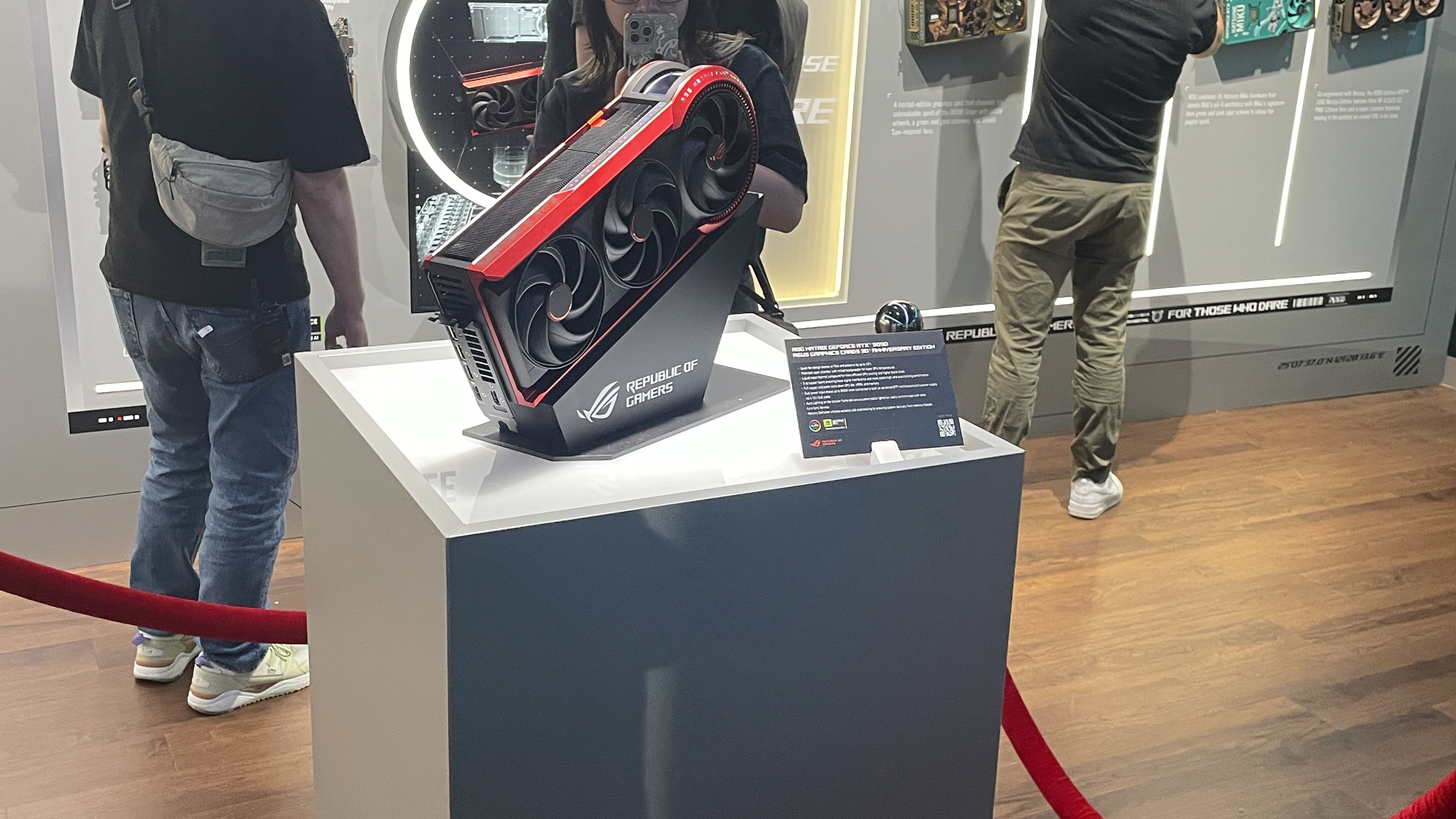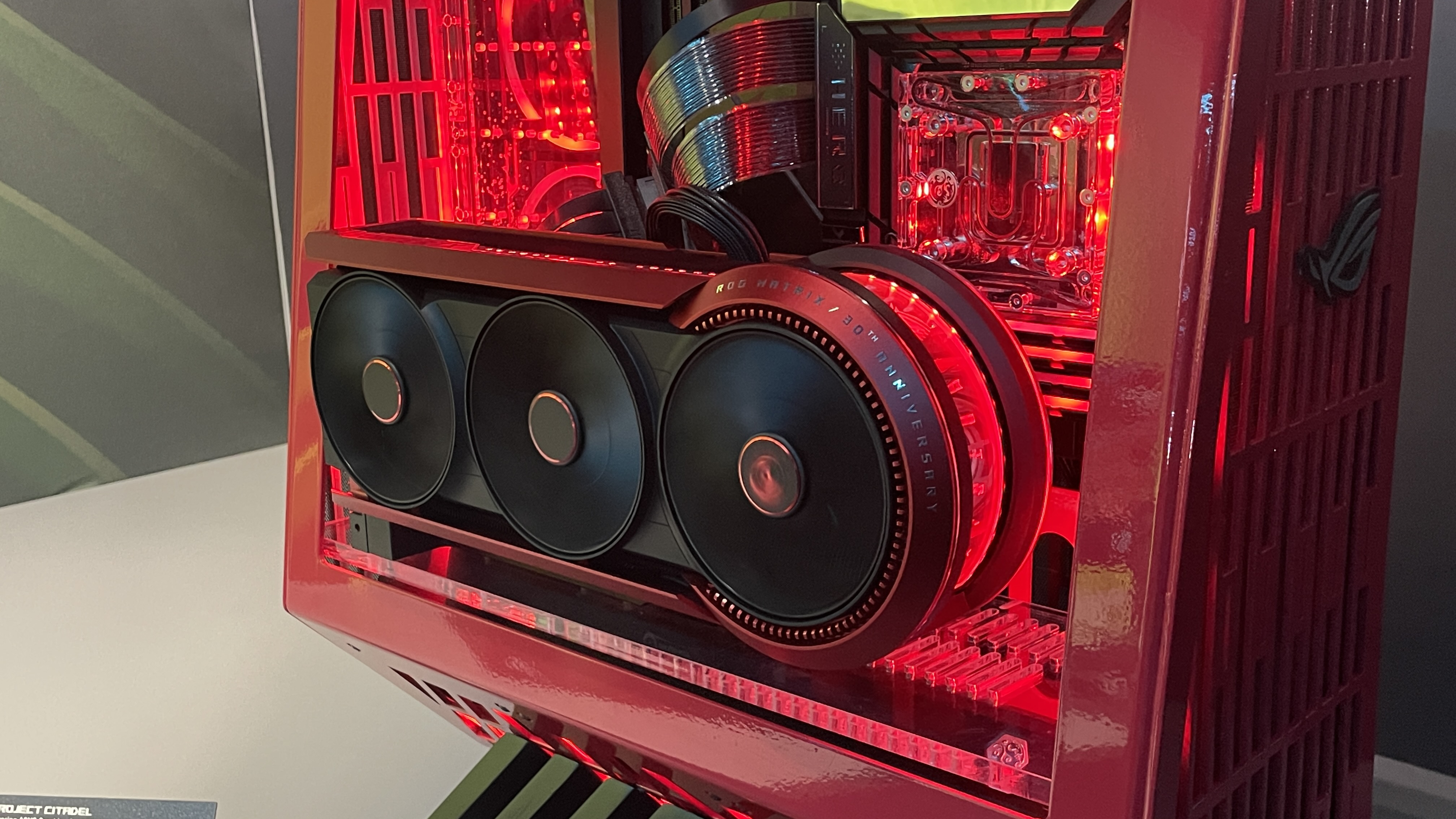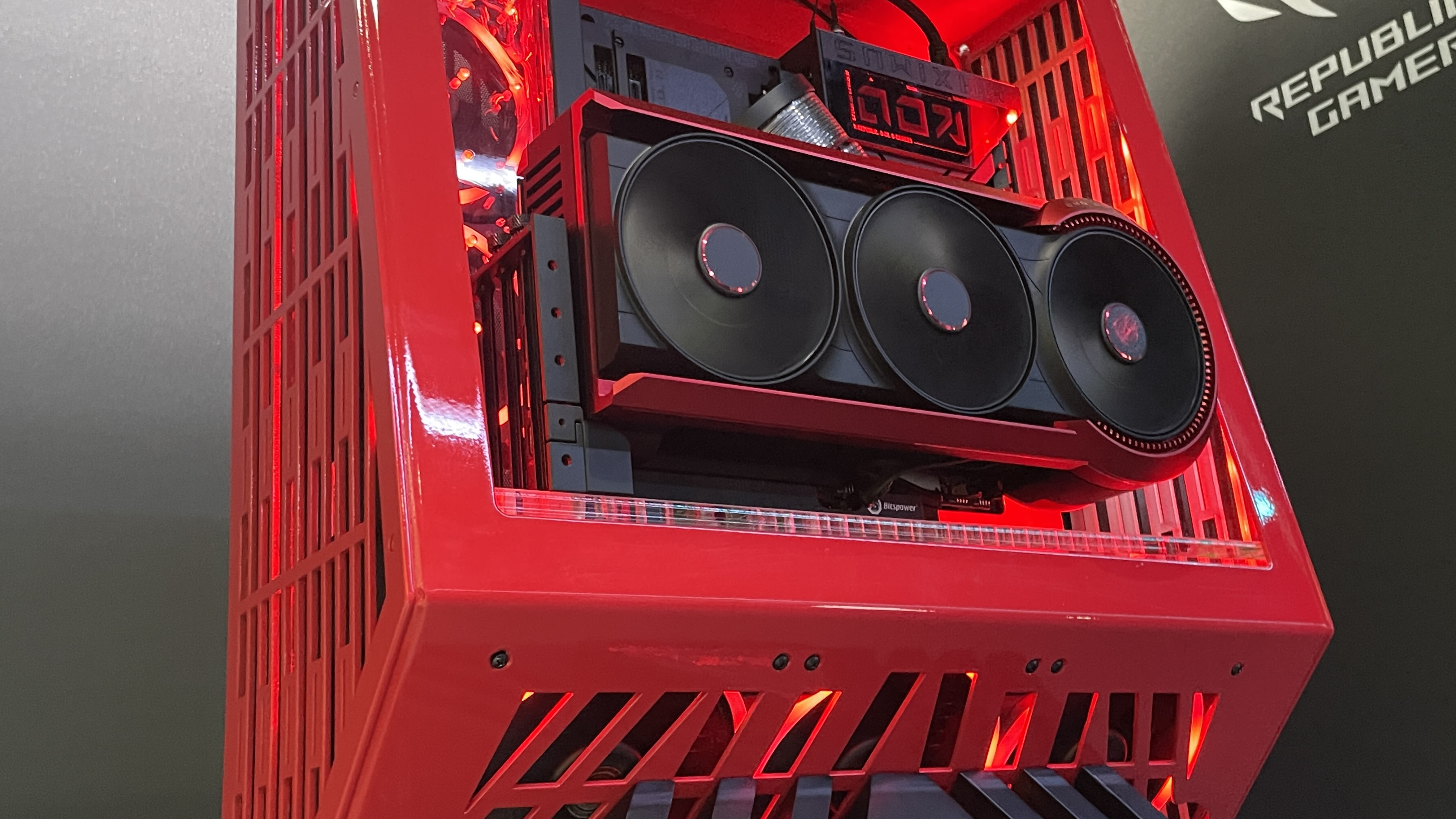Earlier in the year, I got a look at what I called the ideal GPU physique in the form of the Asus ROG Matrix GeForce RTX 5090. This card was announced as a celebration of the company’s 30th anniversary of selling graphics cards, and it’s now officially launched at a price of, er, $4,000.
To be fair, while that’s over $1,000 more expensive than you can find some other RTX 5090 cards going for, and $2,000 more than the Founders Edition RTX 5090’s MSRP, it is also $3,000 cheaper than the gold-plated RTX 5090 Dhahab OC, which started retailing for about $7,000 back in May. There are levels to these things, I suppose.
The new card’s price tag isn’t just down to its dashing good looks, which it does admittedly have in spades, and it’s not only to do with its limited supply of 1,000 cards. It’s also down to its buffed 800 W power draw. Given the default RTX 5090 pretty much maxes out the 12V-2x6 connector’s max wattage, a second power connection is needed to get it up to 800 W.
That’s where the BTF connection comes in. To get this special edition GPU hooked up to all the juice that its cooling and VBIOS is designed to make use of, you’ll need an “Advanced BTF motherboard” in addition to the 12V-2x6 PSU. Then the ROG Matrix RTX 5090 can receive an extra dose of power through the BTF connection via the motherboard and the extra little card edge connector next to the PCIe slot.
Tech YouTuber der8auer has already torn apart and tested the newly released card, and discovered that the performance gains are pretty meagre compared not just to the price premium but also the additional power consumption. According to der8auer, in practice the ROG Matrix RTX 5090 “always consumed about 26% more power, while it was only about 10% faster.”
Image 1 of 4

(Image credit: Future)
Image 2 of 4

(Image credit: Future)
Image 3 of 4

(Image credit: Future)
Image 4 of 4

(Image credit: Future)
That’s after cranking power limits and voltage up in the software. And the GPU’s reported power consumption isn’t the full 800 W it’s rated for. The YouTuber found it to typically consume between 680–730 W in practice at full load, also hitting over 3,000 MHz clock speeds.
In actual gaming workloads, they found this extra power to net pretty small gains compared to a standard RTX 5090, all things considered. Star Wars Outlaws saw a boost from 89 fps to 98 fps at 4K comparing the two cards, and Assassin’s Creed Mirage a boost from 143 fps to 150 fps.
To be fair, though, Asus is very open about this. It says the card can “achieve up to a 10% performance boost” if it’s used with a BTF motherboard that’s feeding it the extra 200 W of power. Which even on paper is just a 10% performance boost for up to 33% extra power.
And this isn’t all too surprising, really, given it’s common that the higher up the premium ladder you go in a product stack, the smaller the gains tend to be. Ie, you pay a lot more for those final small bumps that put it in front of the rest of the mainstream and less premium competitors.

Me, holding the Asus ROG Matrix RTX 5090. (Image credit: Future)
Plus, it’s not all about the performance. In addition to the rarity factor—just 1,000 cards—it looks genuinely stunning. I discovered this in person when I was lucky enough to get up close and personal with one in August. It really is a beautiful card.
After getting an extended period of time with it for testing, der8auer ends up concluding that it is “pretty close to perfection”, from its lovely red and rounded design to its performance. It even runs significantly quieter than the Asus ROG Astral RTX 5090, the company’s main high-end offering.
That’s only “pretty close” to perfection, though, because the YouTuber, who’s certainly done enough tinkering over the years to be a good judge of this, says the application of liquid metal onto the GPU “is not what I would consider perfection.” And while “pretty close to perfection” is great for a standard card, for a limited edition $4,000 product, it might not be too unreasonable to ask for perfection in all areas.
None of this judgment in relation to the price might matter, anyway, because as of the time of writing, the card is all sold out. Which presumably means if you want one, you might have to brave the second-hand market, where I can only assume lucky owners will be able to ask what they like for it, likely well above $4,000.
&
Best graphics card 2025
All our current recommendations
Pick a category Best overallCore ComponentsChairs & DesksSystems & LaptopsScreensPeripheralsCases, Cooling & Storage Choose a list Best CPU for gaming 2025Best graphics card 2025Best gaming motherboard 2025Best Mini-ITX motherboardBest RAM for gaming 2025  BEST OVERALL 1. AMD Radeon RX 9070 Check Price
BEST OVERALL 1. AMD Radeon RX 9070 Check Price  BEST VALUE 2. AMD Radeon RX 9060 XT 16 GB Check Price
BEST VALUE 2. AMD Radeon RX 9060 XT 16 GB Check Price  BEST BUDGET 3. Intel Arc B570 Check Price
BEST BUDGET 3. Intel Arc B570 Check Price  BEST MID-RANGE 4. Nvidia GeForce RTX 5070 Ti Check Price
BEST MID-RANGE 4. Nvidia GeForce RTX 5070 Ti Check Price  BEST HIGH-END 5. Nvidia GeForce RTX 5090 Check Price Read the full guide: Best graphics card 2025POWERED BY
BEST HIGH-END 5. Nvidia GeForce RTX 5090 Check Price Read the full guide: Best graphics card 2025POWERED BY &&&&&&&&&&&&&&&&&&&&&&&&&&&&&&&&&&&&&&&&&&&&&&&&&&&&&&&&&&&&&&&&&&&&&&&&&&&&&&&&&&&&&&&&&&&&&&&&&&&&&&&&&&&&&&&&&&&&&&&&&&&&&&&&&&&&&&&&&&&&&&&&&&&&&&&&&&&&&&&&&&&&&&&&&&&&&&&&&&&&&&&&&&&&&&&&&&&&&&&&&&&&&&&&&&&&&&&&&&&&&&&&&&&&&&&
&&&&&&&&&&&&&&&&&&&&&&&&&&&&&&&&&&&&&&&&&&&&&&&&&&&&&&&&&&&&&&&&&&&&&&&&&&&&&&&&&&&&&&&&&&&&&&&&&&&&&&&&&&&&&&&&&&&&&&&&&&&&&&&&&&&&&&&&&&&&&&&&&&&&&&&&&&&&&&&&&&&&&&&&&&&&&&&&&&&&&&&&&&&&&&&&&&&&&&&&&&&&&&&&&&&&&&&&&&&&&&&&&&&&&&&
From PCGamer latest via this RSS feed
People just keep coming up with stupid new ways to burn down their house, this thing just looks like and electrical fire.


